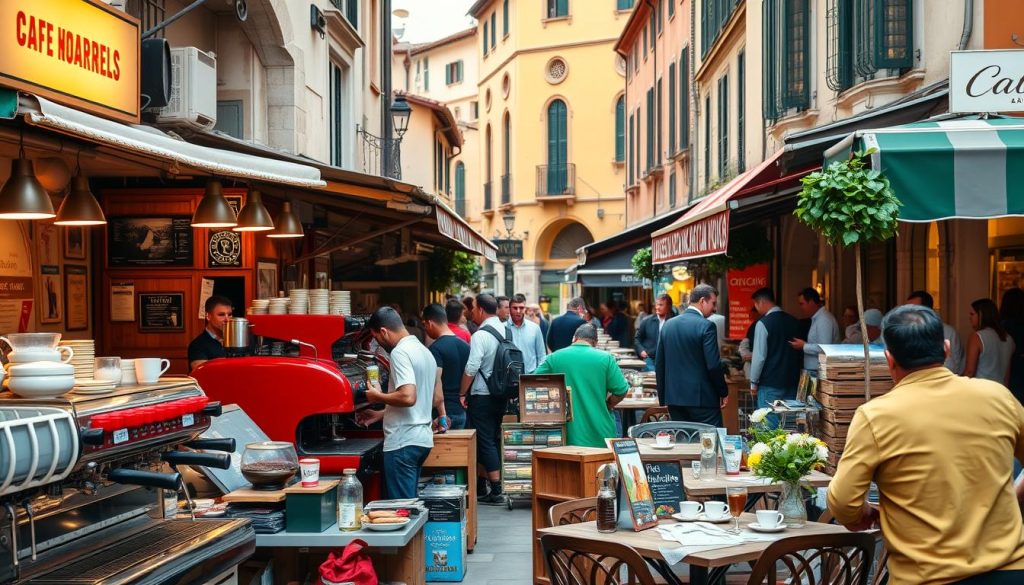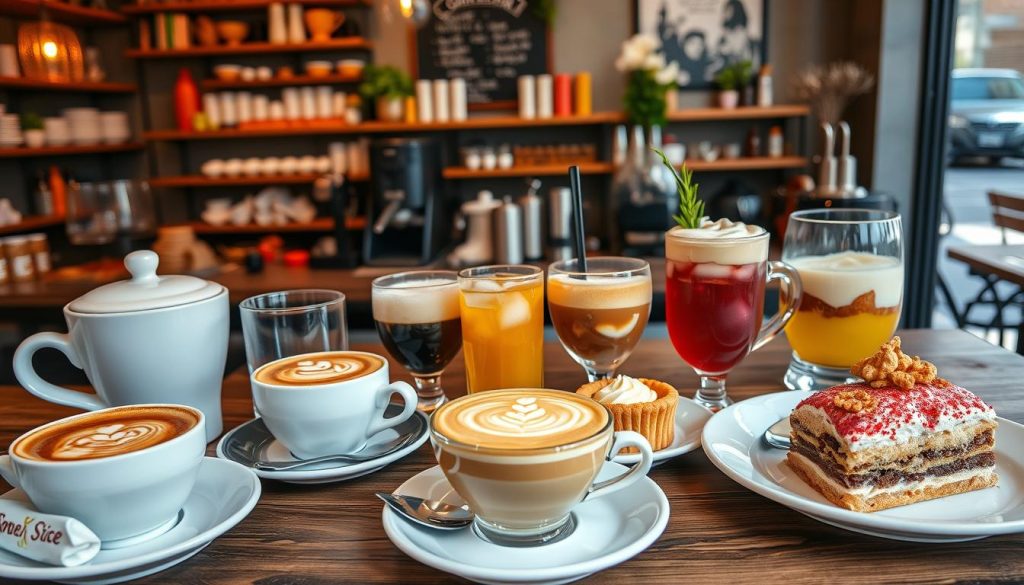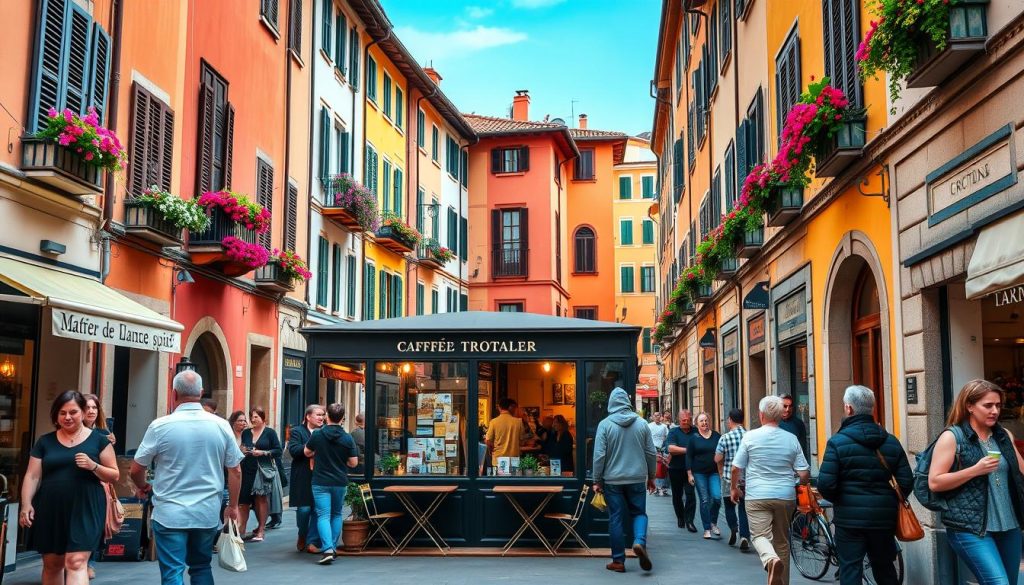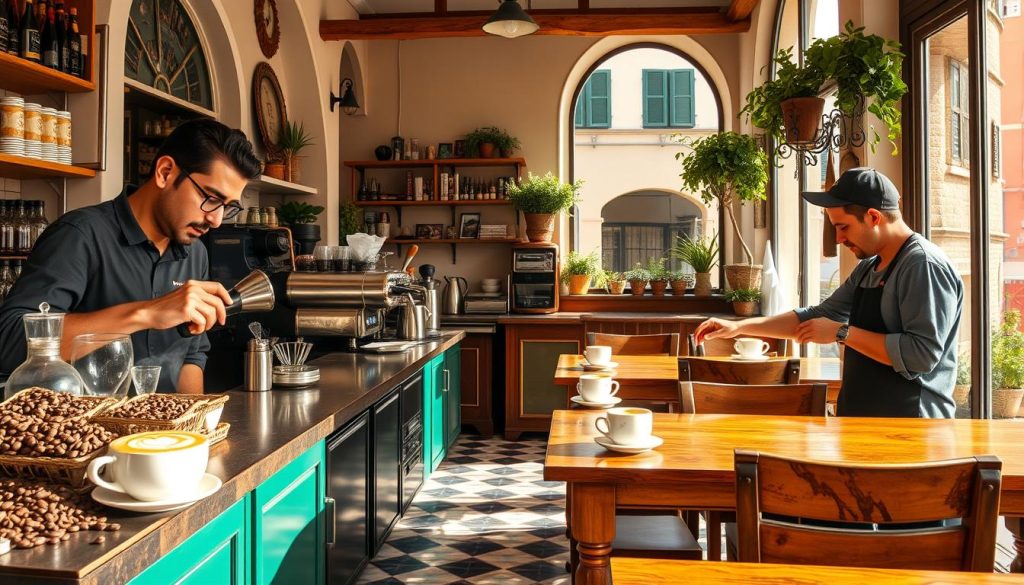Starting a coffee café business in Italy is an exciting journey. We remember Anthony Bourdain’s words, “Your body is not a temple, it’s an amusement park. Enjoy the ride.” These words capture the lively Italian coffee culture we aim to join.
Italy is a key player in the coffee market. In 2022, it imported over 670 thousand tonnes of green coffee. Most of it came from Brazil, Vietnam, and India. This shows Italy’s love for coffee and its growth in the market.
The Italian coffee market is set to grow by about 3% each year until 2028. This makes it a great time to start a coffee café. Famous brands like Lavazza and Illy have already made their mark. We need to do our homework and plan carefully to succeed in this competitive market.
Overview of the Coffee Market in Italy
The Italian coffee market is lively and full of demand. In 2022, Italy imported over 672 thousand tonnes of green coffee, making it Europe’s second-largest importer. People in Italy love their espresso and specialty coffee, made from Arabica and Robusta beans.

Our roasting industry is strong, making up 32% of Europe’s coffee roasting. Coffee from Brazil, Vietnam, and Uganda is key to our imports. Italian buyers often choose affordable Arabica and Robusta beans. Meanwhile, specialty coffee with unique packaging serves a smaller but growing market.
Sustainability is key now. The European Green Deal and the European Corporate Sustainability Due Diligence Directive (CSDDD) push companies to care for the environment. The duty on decaffeinated roasted coffee is 9%. Payment terms usually last from 30 to 45 days, but can go up to 360 days for some.
Italy’s coffee consumption is set to hit nearly 171 million bags soon. This matches production levels and shows a strong coffee demand. Rising coffee prices, due to bad weather and market guesses, affect costs. These issues impact our market and are linked to problems in major coffee-producing countries.
The Unique Italian Coffee Culture
The Italian coffee culture is special worldwide, filled with espresso traditions that shape daily life. Cafés are key places where people come together to enjoy high-quality coffee. Italians often prefer quality over quantity, with each coffee served in just one size.
They choose high-quality Arabica beans for their coffee, making each brew stand out. Espresso, the heart of their coffee, is enjoyed in strong, short shots. Italians usually don’t have milk-based drinks like cappuccino after 12 PM, following a long-standing tradition.
This focus on espresso traditions helps us understand Italy’s coffee habits. Historic coffee houses, dating back to the 17th century, are lively spots for socialising and discussing ideas.
There are many types of Italian coffee, like Caffè Lungo, Caffè Ristretto, and Cappuccino. Each has its own taste, showing the variety of espresso traditions across Italy. Baristas’ skill in blending and roasting is key to making the perfect cup.

As we explore Italian coffee culture, we see a mix of old and new. Traditional methods like moka pots and modern espresso machines coexist. This mix makes Italy’s coffee scene vibrant and engaging. Coffee in Italy is more than just a drink; it brings people together, creating strong bonds.
Why Start a Coffee Cafe Business in Italy?
Starting a coffee cafe in Italy is a great idea. Italy’s coffee culture is rich and strong. There’s a big demand for high-quality and new coffee options.
In 2023, sales of specialty coffees went up by 18%. This shows that people want better coffee. Italy has about 700 coffee roasting companies now.
Lombardy and Veneto are the top places for coffee roasting. This means there’s room for new cafes to grow. They can join the busy market.
Running a coffee shop can be profitable, but we must watch out for costs. Things like equipment and staff wages matter. Keeping an eye on our finances helps us succeed.
- Good customer service is key to our success.
- Knowing who our customers are helps us market better.
- Understanding our area’s demographics and spending habits is important.
The Vertical Farming Initiative in Milan is a sign of growth. It shows we can grow unique coffee. Starting a coffee cafe in Italy is a good move. The market is ready for new ideas and great coffee.

Types of Coffee Products Offering Opportunities
Starting a coffee café business means understanding the many coffee products Italian consumers love. We should focus on both traditional and modern Italian coffee. This way, we can create a menu that truly represents Italy’s coffee culture.
Some iconic coffee drinks we may want to feature are:
- Espresso
- Cappuccino
- Latte
- Flat White
- Cortado
- Americano
We should also offer variations like iced coffee and decaf options. These are great for hot months when people want something cool. Adding milk alternatives like oat, soy, or almond milk is also a good idea. It meets different dietary needs and tastes.
It’s important to think about food items that go well with our coffee. Consider adding:
- Cakes and Pastries – Think croissants, muffins, and decadent slices of cake.
- Sandwiches and Salads – Perfect for lunch customers seeking quick and healthy options.
- Hearty Brunch Dishes – Items like avocado toast and pancakes can appeal to those craving substantial meals.
Our menu could also include smoothies, juices, and hot chocolate. Using flavoured syrups lets customers make their drinks special and unique.
By looking at sales data and listening to customer feedback, we can improve our menu. Adding seasonal or limited-time items keeps things fresh and exciting. This makes sure customers keep coming back for more.

Understanding the Legal Requirements for Cafés
Before we open our coffee café in Italy, we need to know the legal rules. This knowledge helps us as owners and makes sure we follow the law. We must follow many rules, from food safety to import laws, to keep our café safe and legal for our customers.
Mandatory Food Safety Regulations
Food safety rules are the base for any café, including ours. We must make sure all food and drinks meet the General Food Law standards. Important things to remember include:
- Training staff on food hygiene regularly.
- Using Hazard Analysis and Critical Control Points (HACCP) systems.
- Keeping everything clean for a top food hygiene rating.
- Registering our café with local authorities at least 28 days before opening.
Import Regulations for Coffee Products
When we buy coffee, we also need to think about import rules. These rules help the coffee industry be more sustainable. Knowing about the EU Deforestation Regulation helps us choose coffee that’s good for the planet. Key steps include:
- Knowing where our coffee beans come from.
- Checking if we need extra certifications for our imports.

Identifying the Right Location for Your Coffee Cafe
The success of our coffee café business depends a lot on where we choose to open. We need to look at several key factors to increase our chances of success. One important thing is to check how many people walk by.
Looking at who lives nearby is also crucial. We need to know if the area’s income, population, and education match what we offer. This helps us see if our café fits in well.
It’s also important to see what other cafés are doing. By studying our competitors, we can find out what we can do differently. Keeping an eye on new developments in the area can also help, as it might attract more people.
How easy it is to get to our café matters a lot. We should pick a spot that’s easy to find and has plenty of parking. This makes it simple for everyone to visit, including those with mobility issues.
Thinking about the size and layout of our café is also key. We want to create spaces that are both functional and welcoming. This makes our customers happy and keeps them coming back.
In Italy, the best places for cafés are where lots of people, like commuters and students, pass by. Getting a good deal on the lease is vital. With help from franchises like Esquires Coffee, we can find the best spots and deals.
In conclusion, choosing the right location is the first step to growing and succeeding in a competitive market.

Essential Equipment for Running a Coffee Cafe Business
Investing in top-notch coffee café equipment is key to our success. The right tools help us serve exceptional coffee drinks. This meets customer expectations, especially during busy times. We’ll look at the must-have tools for cafés, focusing on espresso machines and grinders.
Types of Espresso Machines and Grinders
Choosing the right espresso machine is crucial for our café. Industrial espresso machines start at £1,500 for 1 group, serving 100-150 cups a day. Larger machines with 4 groups can cost over £6,000, handling 400+ cups daily.
Bean-to-cup machines are great for specialty drinks, starting at £4,000 for instant options. They can go up to £7,500 for fresh milk features.
Grinders are vital for perfecting the flavour from our coffee beans. High-quality grinders ensure a consistent grind size. This affects taste and quality. We should expect yearly costs of £200 to £500 for maintenance.

We also need refrigeration systems and cleaning equipment. Proper refrigeration keeps ingredients fresh. Initial costs for cleaning equipment are £100 to £200. Ongoing costs for consumables, like barista kits and gloves, ensure hygiene.
By choosing the right coffee café equipment, we’ll build a strong base to succeed in the competitive coffee market.
Selecting the Best Coffee Suppliers in Italy
Starting a coffee café in Italy needs the right coffee suppliers. We look for suppliers who value quality and ethics. Italy has many coffee roasters, from small shops to big names like Illy and Lavazza.
Choosing suppliers involves looking at a few key things:
- Origin of Beans: Knowing the coffee’s origin helps us judge its quality and taste.
- Roasting Quality: We need to understand how each roaster works to find the right coffee taste and look.
- Supplier Reliability: We want suppliers who are consistent so we can meet our customers’ needs every day.
Artisan brands like Caffè del Doge and Tazza d’Oro offer rich flavours and a true Italian experience. Caffè del Doge started in 1952 and now exports, while Tazza d’Oro is known for its top-notch coffee.
Brands like Kimbo, from Naples since the 1960s, and smaller roasters like San Giusto Caffè in Trieste, show the wide range of coffee available. Knowing about different regions in Italy, like Florence’s Gearbox Coffee Roasters, helps us choose the best coffee.

Working with Italian coffee suppliers improves our café’s quality. It also lets us teach our staff and customers about the unique tastes of each region. By choosing ethical sources, we respect Italian coffee tradition and help the planet.
Building Relationships with Roasters
Building strong relationships with coffee roasters in Italy is key for our café. These connections let us offer unique flavours and quality. By tasting their coffee, we learn about their craft and the different blends.
To work well with roasters, we can try a few things:
- Regular Tastings: Joining or hosting cupping sessions helps us find new flavours and know what we like.
- Understanding Sourcing Methods: Knowing where and how beans are sourced adds to our story. It attracts customers who value quality.
- Negotiating Terms: Getting good deals helps us keep prices low. This lets us offer special deals and stay profitable.
- Creating Exclusive Blends: Working closely with roasters, we can make special blends just for our café. This makes us stand out.
In Italy, the coffee roaster market is booming. This gives us a chance to learn what customers like. With coffee culture growing, focusing on supplier relationships can really help us succeed. It makes our menu better and builds loyalty with our customers.

Marketing Your Coffee Cafe Business
To succeed in the competitive coffee market, we need effective marketing strategies. These should connect with customers, boost brand awareness, and build loyalty. A strong online presence is key to promoting your café. It helps us engage with our community and draw in new customers.
Leveraging Social Media and Online Marketing
In today’s digital world, using social media and online marketing is crucial. About 98% of people look for new businesses online. Sites like Facebook, Instagram, Twitter, and TikTok are great for connecting with our audience.
Nearly 70% of 18 to 49-year-olds are on Instagram. This makes it a top choice for sharing our café’s special offerings through visuals.
- Online ordering systems attract time-pressed customers.
- QR code menus streamline ordering and cut costs.
- Email marketing keeps customers updated on deals.
- Seasonal promotions create buzz.
Creating a Unique Brand Identity
Having a unique brand identity is essential to stand out. This means creating a striking logo, unique packaging, and a consistent message. Working with local businesses can boost our brand. Adopting eco-friendly practices also appeals to environmentally conscious customers, strengthening our community bonds.
- Hosting coffee education workshops showcases our expertise.
- Loyalty programs encourage repeat visits and increase customer value.
- Diversifying our customer base through influencer marketing attracts more people.

Hiring Skilled Baristas and Staff
Our café’s success comes from hiring staff who love their job and are good at it. Baristas in Italy know a lot about coffee and how to serve customers well. This makes our customers happy.
We use different ways to find staff. Online job sites and social media help us reach many people. But, we might get lots of applicants who aren’t right for the job. Starting a referral program can help, but it might not bring in new people.

Baristas in London usually earn about £11.38 an hour. Pay can vary from £7 to £14 based on experience. We need to pay well to get the best baristas.
Junior baristas start at around £19,760 a year. More experienced ones can earn up to £76,247. Giving bonuses and extra pay can keep our team happy and motivated.
For flexibility, we can use on-demand job sites. They let us hire baristas for short periods. It’s also important to train our baristas well. This helps keep our brand strong and our team happy.
When we hire, looking for people who love serving others is key. We can find great baristas at Latte Art Throwdowns, local roasters, and online. This helps us build a strong team.
Offering a Diverse Menu to Attract Customers
Having a diverse café menu is key to drawing in more customers. We offer traditional Italian café items and creative twists. This mix attracts more visitors and boosts our sales.
Seasonal menus with local ingredients make our café special. They show off the region’s flavours all year. We have options for breakfast, lunch, and snacks, making our place lively and inviting.
Getting the right equipment for food is important for smooth operations. Marketing our food on social media creates buzz. Instagram and Facebook are great for sharing delicious food photos and drawing in customers.
Unique features like coffee tasting flights attract a wide range of customers. A loyalty programme keeps them coming back. Events and local artist partnerships make our café stand out.

Our café is more than just a coffee shop. It’s a place for relaxation, work, and socialising. We offer mobile ordering and plenty of parking for convenience. Our top-notch service makes customers want to come back and share their positive experiences with others.
Understanding Customer Preferences in Italy
It’s key to understand what Italian customers like for our café to do well. The coffee scene in Italy shows a changing taste among people. By looking into these changes, we find out what makes our menu special.
More people in Italy are choosing premium coffee. They want single-serve options that are still top-notch. This trend fits with Italy’s big agribusiness sector, showing how important quality and making things by hand are.
Where you are in Italy affects what coffee you like. In Milan and Venice, folks prefer espresso that’s bright and acidic. In Tuscany and Rome, they want a stronger taste. Naples loves coffee that’s very rich, like dark chocolate. Knowing these local tastes helps us make our menu better.
- Quality matters: Customers show a preference for high-quality blends over mass-produced options.
- Diversity is key: Offering a range of formats such as whole bean, ground, and capsules helps cater to varied preferences.
- Eco-conscious choices: A growing awareness of environmental issues influences purchasing decisions, leading to a demand for sustainable packaging and sourcing practices.
We can offer a unique café experience by catering to different tastes. Our Tales of Italy coffee range is perfect for this. It keeps true to Italian coffee traditions and highlights the unique tastes of each region.

Adapting Your Cafe to Trending Coffee Practices
The coffee world is always changing, thanks to new trends and what people want. Our café needs to keep up to stay ahead. One key thing is to adapting café offerings to meet different tastes.
Adding milk alternatives like soy, oat, or almond makes our menu more flexible. This move attracts more people and keeps them coming back. We should show off vegan, gluten-free, halal, and dairy-free choices on menus and online.
Listening to what customers say helps us improve. By making our menu based on what they ask for, we make them happier. Asking about dietary needs when taking orders shows we care about everyone.
Changing our menu to include vegan, dairy-free, or gluten-free options is easier than you think. It also makes our café more welcoming. Plus, getting café and coffee shop insurance helps protect us from risks.

Keeping up with coffee trends can really help us attract and keep customers. By being informed and proactive, our café can not only survive but flourish in this fast-changing world.
Future Trends Shaping the Italian Coffee Industry
Looking ahead, the Italian coffee industry will be shaped by new trends. The global coffee market is expected to grow from US$132.1 billion in 2024 to US$166.4 billion by 2029. We must adapt to these trends to stay ahead.
Younger consumers, especially Gen Z, are starting to drink coffee earlier. They want a café experience that fits their lifestyle. This is a big change for the industry.
Sustainability is also becoming more important. Millennials and Gen Z prefer brands that care about the environment. They want coffee that’s good for the planet, like sustainable farming and climate-resistant beans.
Convenience is another key trend. The pandemic made people prefer coffee at home. This has led to more sales of instant coffee and ready-to-drink formats. We should think about offering new things like bottled coffee and functional beverages.
Understanding these trends is essential for the Italian coffee industry’s future. It will help us stay competitive and meet our customers’ needs.









